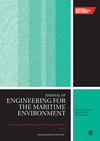基于统计数据的船舶结构钢板腐蚀模型
IF 1.5
4区 工程技术
Q3 ENGINEERING, MARINE
Proceedings of the Institution of Mechanical Engineers, Part M: Journal of Engineering for the Maritime Environment
Pub Date : 2024-05-29
DOI:10.1177/14750902241253319
引用次数: 0
摘要
为制定适当的船舶和近海结构维护政策,有必要准确预测腐蚀损耗。本研究的主要目的是为船舶结构中的板材提出腐蚀模型。从不同船级社进行的厚度测量中总共收集了 66 480 个数据。这些数据根据钢板的位置、船龄、船舶建造国和船舶类型进行了分类。通过回归分析,提出了一些与船龄和钢板位置相关的模型。研究发现,其他腐蚀模型低估了内底板和甲板的腐蚀率。但是,它们高估了船舶侧板的腐蚀量。现有的腐蚀模型在预测舱口盖板的腐蚀损耗方面是合理的。对于外底板的腐蚀,现有的腐蚀模型适用于船龄在 20 年以下的船舶。对于船龄超过 20 年的船舶,这些模型高估了腐蚀损耗。此外,现有的腐蚀模型高估了早期船龄船舶水线以上船侧结构板的腐蚀损耗,低估了老龄船舶的腐蚀损耗。本文章由计算机程序翻译,如有差异,请以英文原文为准。
Corrosion models for steel plates in ship structure based on statistical data
To have a proper maintenance policy for ships and offshore structures, it is necessary to predict corrosion wastage accurately. It is the main aim of the present work to propose corrosion models for plates in ship structures. In total 66,480 data were collected from thickness measurements carried out by different classification societies. The data were sorted out based on the position of the plate, the age of the ship, the country where the ship was built, and the type of ship. Using regression analysis, some models were proposed as a function of the ship’s age and position of plate. Based on this study, the proposed models are checked against existing corrosion models in the literature and it is found that other corrosion models underestimate the corrosion rate in the inner bottom plates, and deck plates. However, they overestimate the amount of corrosion in the side plates of ships. The existing corrosion models are justified for the prediction of corrosion wastage in hatch-coaming plates. For corrosion of outer bottom plates, the existing corrosion models are applicable for ships under 20 years old. They overestimate corrosion wastage for ships older than 20 years. Also, existing corrosion models overestimate corrosion wastage of plates at the side structure of ships above the water line at the early age of ships and underestimate in older ships.
求助全文
通过发布文献求助,成功后即可免费获取论文全文。
去求助
来源期刊

CiteScore
3.90
自引率
11.10%
发文量
77
审稿时长
>12 weeks
期刊介绍:
The Journal of Engineering for the Maritime Environment is concerned with the design, production and operation of engineering artefacts for the maritime environment. The journal straddles the traditional boundaries of naval architecture, marine engineering, offshore/ocean engineering, coastal engineering and port engineering.
 求助内容:
求助内容: 应助结果提醒方式:
应助结果提醒方式:


